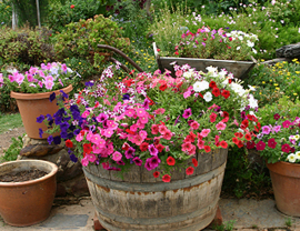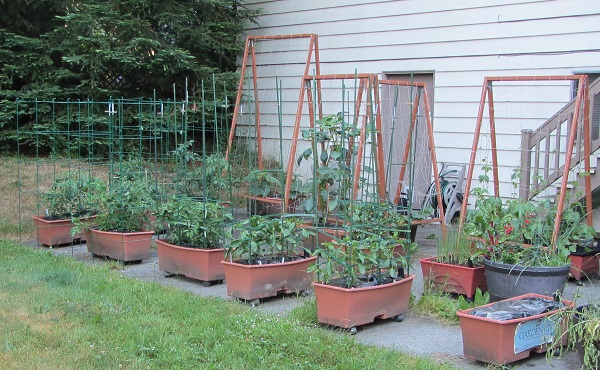Container Gardens
If you would like to have more control over growing conditions and enjoy higher yields with less work – garden in containers.
Use barrels, buckets, baskets, boxes, tubs and troughs – basically anything that holds soil. Just be sure that it has drainage holes in the bottom. Keep this in mind – plastic pots won’t dry out as fast as unglazed terra-cotta ones and black pots absorb heat when they are sitting in the sun.
Hanging baskets make good use of extra space; herbs, cherry tomatoes, and strawberries grown at eye level can be easily tended and harvested.
Most vegetables need six to eight hours of direct sun in order to thrive and produce. Plants in containers need the best possible soil, aeration, and drainage for healthy root growth and optimum harvest. DO NOT use soil from the garden, it is too heavy and becomes waterlogged. Choose a soilless mix or use compost combined with a soilless mix. Keep plants growing by feeding them liquid seaweed, fish emulsion or manure tea weekly.
Vegetables need consistently moist soil to ensure growth. In fact, plants grown in pots must be watered as often as twice a day. Here’s a hint to keep plants adequately cool and moist during the hot summer days – double pot! Place a small pot inside a larger one and fill the space between them with sphagnum moss or crumpled newspaper. When watering the plant, soak the filler between the pots also.
Use trellises, stakes, netting, twine, or cages with climbing vegetables. A teepee of bamboo stakes will hold pole beans or snap peas. Cucumbers trained to climb up a nylon mesh fence will develop fruit that hang down and grow straight. Be sure to put the supports in place at the time of planting to avoid damaging the plants or roots.
Plant root crops, low growers, and tall climbers together in the same container to maximize your space. The climbers will scramble up a trellis, while the small plants spread around their base. AND, no need to weed because there won’t be room for them to grow. During the heat of the summer, some low growers like leafy greens will thrive in the shade provided by the taller plants. Be sure to mix quick-maturing plants, lettuce or radishes, with longer growing ones, tomatoes or broccoli. It is best to group plants with similar needs for sun and water; pole beans/radishes/lettuce OR bush beans/cucumber/beets OR tomatoes/basil/onions OR peas/carrots.
Checkout seed catalogs, many will list varieties of vegetables that are bred specifically for growing in containers.
Container size suggestions:
10 gallon pot
- 15 peas that are spaced 6 inches apart
- 15 pole beans that are spaced 6 inches apart
- long carrots – plant lots and thin them out as they grow
- 1 tomato plant
- 24 beets
- 3 eggplants
- 5 chards
- 2 melons
- 2 squashes
- 3 cabbages
5-gallon pot
- 2 broccoli
- 1 melon
- long carrots
- 1 cucumber
2-gallon pot
- 6 bush beans that are spaced 4 inches apart
- baby carrots
- 7 beets
- 1 cabbage
- 1 chard
- 1 pepper
1-gallon pot
- lettuce
- radishes
- baby carrots
Suggestions from The Old Farmer’s Almanac

